eOrganic author:
Dr. Mark Schonbeck, Virginia Association for Biological Farming
Abstract
Organic weed management strategies for squash, cucumber, melon, and other cucurbit crops combine measures to reduce weed populations prior to planting, control weeds early in crop development, and maximize the crop's ability to outcompete weeds. Under favorable conditions, cucurbits kept weed-free for the first 4–6 weeks after planting tolerate later-emerging weeds, and can hinder weed growth through canopy closure.
Weeds that emerge after cucurbit vines begin to spread have little direct effect on yield, but can interfere with harvest, promote disease, or propagate themselves. Organic weed management is especially challenging at this time, because mechanical cultivation can damage crop vines and shallow feeder roots, and manual removal is labor intensive. Late-emerging weeds can set many seeds, especially during the long maturation periods of winter squash, pumpkin, and watermelon.
Some of the most troublesome weeds of cucurbit crops in the southern United States include nutsedges, bermudagrass, morningglories, pigweeds, common cocklebur, ragweeds, and horsenettle.
Preventive measures include designing crop rotations to facilitate control of these weeds during the year preceding a cucurbit crop, preparing a stale seedbed or cultivated fallow several weeks prior to planting, and providing optimal growing conditions for the crop. Planting in warm soil (≥70 °F) with adequate but not excessive moisture and nutrients is especially important for promoting rapid crop emergence, establishment, and canopy closure.
Most organic farmers use one of the following weed control strategies during cucurbit production:
- Plastic film or other synthetic mulch, laid just before planting; alley weeds managed with cultivation, mowing, organic mulch, or cover crops.
- Timely cultivation and hoeing from planting until the vines spread sufficiently to make further cultivation impractical.
- Organic mulches, such as straw applied after one or two cultivations, or cover crops mowed or roll-crimped just before no-till planting.
Manual removal of late-season weeds can pay off in the long run by facilitating harvest and reducing deposits to the weed seed bank.
This article outlines organic weed management strategies and techniques for cucurbits, based on an understanding of:
- General principles of ecological weed management
- Growth habit and life cycles of cucumber, squash, and other cucurbit crops
- Cultural methods and production systems for organic cucurbits
- Inherent vulnerabilities and strengths of these crops in relation to weeds
Introduction
Cucumber, winter squash, and other cucurbit crops require good weed control during early stages of crop development. Once established, they tolerate most later-emerging weeds without significant yield reductions. However, late season weeds require management to prevent weed propagation, to maintain good air circulation for the crop, and to facilitate harvest.
Crop Life Cycle and Growth Habit, Impacts of Weeds, and Minimum Weed-Free Period
Cucumber, squash, melon, pumpkin, and other members of the cucurbit family are heat-loving summer annual vegetables, and should be planted in warm soil to get off to a good start. Seedlings emerge within 3–4 days after direct-sowing at soil temperatures of 77–95 °F, take 6–12 days at 68 °F, and may fail to emerge from soil cooler than 60 °F (Maynard and Hochmuth, 1997).
Most cucumber, melon, and winter squash cultivars grow as spreading vines, whereas zucchini, summer squash, and a few varieties of cucumber and winter squash have a more compact (bush) growth habit. With optimal warmth, moisture, and soil fertility, cucumber and winter squash grow rapidly, and begin sending out vines within 25–35 days after planting. Depending on cultivar, row and plant spacings, and growing conditions, the crop may close canopy (foliage completely covers the ground within and between rows) by 40–60 days after planting. Fruits set, develop and become harvest-ready approximately 45–60 days (cucumber, zucchini, summer squash) or 80–120 days (winter squash, pumpkin, melon) after planting.
Development of cucumber, winter squash, and other vine-forming cucurbits can be described as three phases:
- Emergence and establishment, from planting until the transition from upright to prostrate growth (sometimes called tip-over)
- Rapid vegetative growth, from tip-over until canopy closure or full vine development
- Mature crop, from canopy closure until end of harvest
For summer squash and other cultivars with an upright growth habit, these phases correspond approximately to: planting to a height of 12–18 inches; from this point until first fruit; and first fruit until end of harvest.
The minimum weed-free period (when the crop must be kept weed-free to prevent yield losses to weed competition) in cucumber, squash, and other cucurbit crops has been estimated as the first 4 to 6 weeks after planting (Friesen, 1978; Noble, 2009; Peet, 1996; Stall, 2009; Ron Morse, Horticulture Dept., Virginia Tech, pers. commun.). Vine-forming cultivars usually pass through their minimum weed-free period when the vines begin to occupy the inter-row spaces. Delays in crop development lengthen the minimum weed-free period, and may result from:
- Choice of crop varieties not well adapted to local climate and soils
- Poor seed quality
- Cool or wet soil conditions
- Inadequate soil moisture, nutrients, or organic matter
- Heavy pest or disease pressure
Early or out-of-season plantings often get off to a slower start owing to lower temperatures, even with season extension measures; thus, they require more diligent weed control (UC Davis, 2008). Many organic growers transplant their earliest cucumber and squash plantings to minimize this problem. Transplanting cucurbit crops requires care to minimize transplant shock; starting plants in fairly large individual cells is strongly recommended. However, transplanting can give the crop a substantial head start on the weeds, and is thus an important weed control tactic in organic production of these crops.
The crop is most vulnerable to weed competition during the emergence and establishment phase, and is also easiest to keep clean through cultivation during this time (Fig. 1). When plants are established but vines have not yet begun to run out (Fig. 1b), cucurbit crops can tolerate a moderate amount of hilling-up (soil moved into the row), a practice that buries and kills within-row weed seedlings.
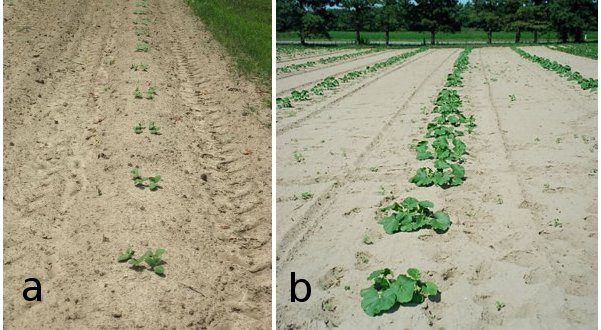
Figure 1. (a) Winter squash a few days after emergence. (b) Winter squash shortly before the onset of vine spread. Timely shallow cultivation during this period can greatly reduce weed competition with the crop. Photo credit: Mark Schonbeck, Virginia Association for Biological Farming.
The phase of rapid vegetative development is most challenging for weed control in cucumber, melon, and winter squash, because the spreading vines make it increasingly difficult to cultivate without damaging the crop (Fig. 2). Cucurbits form extensive root systems with many shallow feeder roots spreading as wide as or wider than the vines themselves. It is important to avoid damaging these roots by cultivating too deeply or too close to the row. Moving or turning the vines in order to cultivate closer to the row has been found to reduce crop vigor and yield (Stall, 2009; Charlie Maloney, farmer in the Tidewater region of Virginia, pers. commun.). Bush varieties can be cultivated or hoed between the rows, with due care to protect feeder roots.
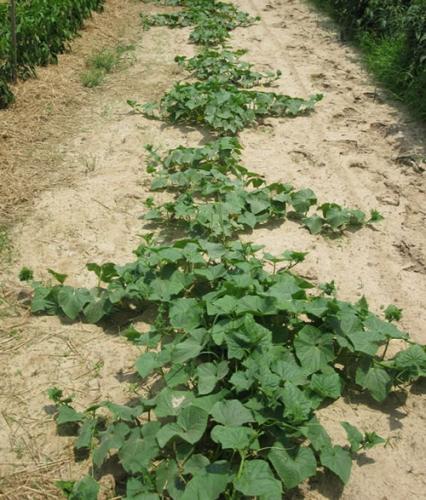
Figure 2. Mechanical cultivation is no longer feasible in this cucumber crop, but shallow manual hoeing to remove the small weeds between the vines can reduce late season weed levels and facilitate harvest. Photo credit: Mark Schonbeck, Virginia Association for Biological Farming.
Although cucurbits become less vulnerable to weed competition after the vines run out (or when bush varieties become well established), the crop may take a few more weeks to close canopy. Weeds that emerge during this time may complicate harvest by concealing fruit or hampering manual picking with prickly foliage or entangling vines, and promote fungal diseases by limiting air circulation. Horsenettle and black nightshades are hosts for the cucurbit powdery mildew fungus (Erysiphe cichoracearum), and many common weeds (pigweeds, nightshades, purslane, bindweeds, etc.) can carry cucumber mosaic virus (CMV).
Weeds emerging in a mature cucurbit crop usually have little direct impact on yield, and a well developed crop canopy can suppress the growth of newly-emerging weeds (Fig. 3). Winter squash and pumpkin usually form heavier, more weed-suppressive foliage than cucumber or melon, although some vigorous Japanese cucumber varieties have been observed to close canopy 6 weeks after transplanting (Anthony Flaccavento, farmer in southwest Virginia, pers. commun.). Gaps in the crop stand, or late season defoliation by pests, disease, or plant senescence can result in more late-season weed growth.

Figure 3. After good early-season weed control, vigorous crops of winter squash (right), cucumber (center), and sweet potato (left) have formed closed canopies, thereby suppressing late-season weeds. Photo credit: Mark Schonbeck, Virginia Association for Biological Farming.
In some cases, moderate late-season weed growth has proven beneficial in reducing sunscald on fruits, especially watermelon (Andy Hankins, Extension Specialist, Virginia State University, pers. commun.).
Cultural Practices and Weed Management
Many producers grow a high biomass winter or spring cover crop to build organic matter and add nitrogen (legumes) prior to planting a cucurbit crop. A good cover crop suppresses winter annual and perennial weeds, but may not suppress summer weeds if it is tilled in.
Cucumber is usually planted in rows 4–6 feet apart, and thinned to stand 6–15 inches apart within the row. Closer row and within-row spacing promotes canopy closure and weed suppression. Wider spacing facilitates tractor cultivation between rows, and may reduce disease by improving air circulation. A few growers plant cucumber in hills 3–4 feet apart and thin to 3 plants per hill, which can facilitate close cultivation early in development.
Cucumber may be grown in plastic-mulched beds with in-row drip irrigation, in clean-tilled beds without mulch, or occasionally with organic mulches such as straw or rolled-down winter cover crops. Black plastic mulch speeds soil warming and early crop growth, suppresses most weed growth within the bed, and allows cultivation of alleys until vines spread beyond the plastic-mulched area. Organic mulches can slow soil warming and delay crop development, and are best used on later plantings when the soil is warm, or in alleys between plastic-mulched beds.
Cucumber and melon are sometimes trellised, especially in hoop house production. Trellising improves fruit quality, reduces disease problems, and improves access to between-row alleys for cultivation, mulching, and harvest. The upright growth habit of most zucchini and summer squash similarly facilitates between-row weed control.
Farmers often make several successional plantings of cucumber, zucchini, and summer squash, beginning after the spring frost date and continuing into July. These crops are most often direct-sown, although some growers start early crops in the greenhouse and transplant seedlings for earlier maturity. Harvest typically begins 45–60 days after planting, and continues for 15–30 days, for a total cropping period of 60–90 days for a given planting. The short cropping cycle facilitates post-harvest weed management to limit weed propagation (Fig. 4).
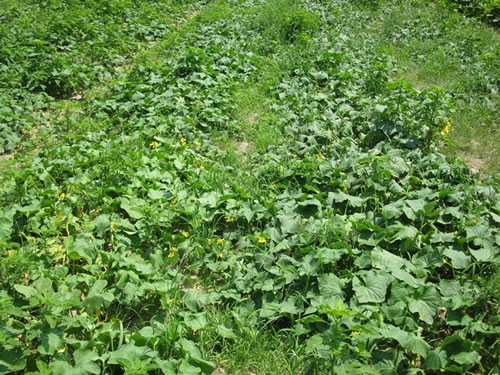
Figure 4. The weeds emerged after the crop was well established, and the farmer reported high crop yields. Prompt tillage or mowing after harvest is complete will curtail seed set. Photo credit: Mark Schonbeck, Virginia Association for Biological Farming.
Winter squash is usually planted in rows 6–8 feet apart, with individual plants spaced 1–3 feet apart. Row and plant spacing may depend on variety, as some types (e.g., Buttercup and large pumpkins) have extensive vines, whereas others (e.g., Delicata and Acorn) are more compact. The crop is sometimes planted in hills (2–3 plants per hill), which can be spaced equidistantly 6–8 feet apart in both directions. This allows for cross-cultivation (tractor run two ways through the field) for more efficient weed control, though it may also delay canopy closure. The crop is direct-sown or transplanted in late spring or early summer, usually a few weeks after the spring frost date when the soil has thoroughly warmed. Because winter squash is less intensively managed than cucumber and melon, it is usually not mulched or drip-irrigated, and is almost never trellised.
Winter squash and pumpkin are usually harvested once-over in the early fall. Farmers usually harvest these crops 100–120 days or more after planting, waiting longer than a variety's days-to-maturity to allow later-setting fruit to ripen. Because of the long cropping cycle, weeds that emerge after the final cultivation can set seed unless they are removed manually or by mowing (Fig. 5).

Figure 5. The pigweed emerged late enough not to affect winter squash yield, but it has set mature seed during the crop's long maturation period. Manual pulling or cutting several weeks earlier would have prevented a large deposit in the weed seed bank. Photo credit: Mark Schonbeck, Virginia Association for Biological Farming.
Most Serious Weeds in Cucurbits in the Southern Region
Some of the most widespread and troublesome weeds in cucurbit crops in the Southern region include: pigweeds (Amaranthus spp.), especially Palmer amaranth (A. palmeri); yellow and purple nutsedges (Cyperus esculentus and C. rotundus.); and morningglories (Ipomoea spp.) (Webster, 2002; Webster, 2006) (Fig. 6). Bermudagrass (Cynodon dactylon), crabgrass (Digitaria spp.), horsnettle (Solanum carolinense), common and pink purslanes (Portulaca oleracea and P. pilosa), Florida pusley (Richardia scabra) and sicklepod (Cassia obtusifolia) have been cited as widespread or troublesome in several Southern states.
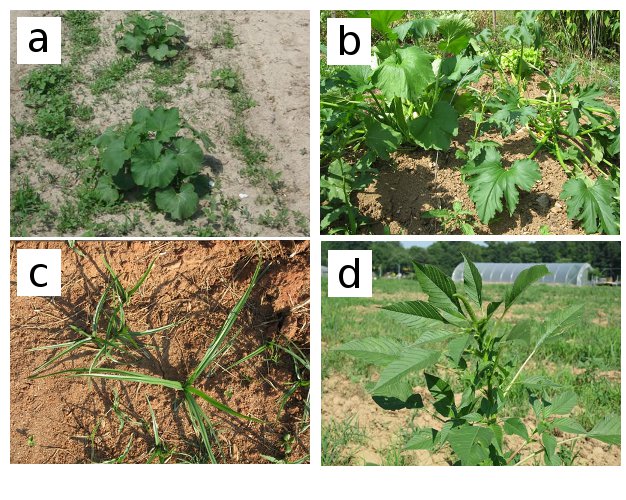
Figure 6. A rogue's gallery of weeds for cucurbit crops. (a) Pigweed, two species of morningglory, and summer annual grasses have emerged during the critical weed-free period of this summer squash. (b) This horsenettle will not affect the zucchini yield, but its nasty spines will complicate manual harvest.(c) Purple nutsedge can compete severely for moisture and readily penetrates synthetic mulches. (d) Palmer amaranth is especially aggressive in hot climates. Photo credit: Mark Schonbeck, Virginia Association for Biological Farming.
Tall, fast-growing summer annual weeds like pigweeds, sicklepod, common cocklebur (Xanthium strumarium), and common ragweed (Ambrosia artemesiifolia) often emerge with the crop and can compete severely unless removed by timely cultivation. Field trials in Florida showed that just one or two pigweed plants per square yard growing with cucumber throughout the cropping cycle can reduce yields by 10%, while 5–7 weeds per square yard can cut yields by half or more (Berry et al., 2006).
Invasive rhizomatous perennials like nutsedges, bermudagrass, and johnsongrass (Sorghum halapense) are difficult to control during cucurbit production. Viny weeds like morningglories, hedge bindweed (Calystegia sepium), and field bindweed (Convovulus arvensis) twine around and may cover the crop, and interfere with mechanical or manual harvest. Viny weeds are especially apt to grow toward and emerge through planting holes in plastic-mulched crops, and the nutsedges often puncture and grow through the plastic itself.
Field workers find the prickly weed horsenettle a major nuisance during harvest (Fig. 6b). It has been cited as the most troublesome weed of cucurbits in Oklahoma (Webster, 2006).
Hairy galinsoga (Galinsoga ciliata) has been cited as troublesome in cucurbit production in Tennessee (Webster, 2002) and Virginia (Ron Morse, pers. commun.) With its extremely short life cycle (30 days from emergence to seed), galinsoga completes two or three generations in a single season, and can form dense stands late in the season that create a wet microclimate around the crops, thereby promoting diseases.
Weeds in the cucurbit family, such as bur cucumber (Sicyos angulatus) and wild gourd (Cucurbita pepo), can harbor squash bug (Anasta tristis) (Adam, 2006) and should be removed. Wild gourd should be eliminated anywhere within a quarter mile of seed production of C. pepo squash or pumpkin varieties to avoid cross pollination with the wild relative that can introduce genes for intensely bitter and toxic cucurbitacins (Connolly, 2005).
Preventive Weed Management in Cucurbit Crops
Begin preventive weed control during the year prior to cucurbit production. If practical, choose a field that is relatively free of nutsedges, Bermuda grass, johnsongrass, bindweeds, and morning glories. Prevent seed set by pigweeds, common cocklebur, and other aggressive summer annual weeds (Peet, 1996). Avoid growing cucurbits the year after another summer annual vegetable with a similar schedule of tillage, planting, cultivation, and harvest—especially if summer weed populations are high. Grow cool season vegetables and weed-competitive summer cover crops (e.g., snap pea–buckwheat–fall broccoli) during the year prior to a cucurbit crop to disrupt summer annual weed life cycles.
In fields with heavy weed populations, draw down the weed seed bank with cultivated fallow or stale seedbed. A final flame-weeding or blind cultivation can be done two or three days after direct seeding, just before crop emergence.
Choose vigorous varieties that are well adapted to local conditions, and that produce heavy foliage to suppress weeds. Provide optimal growing conditions to give the crop a competitive edge. Cucurbits like soils rich in organic matter and biological activity that release nutrients gradually throughout the summer. Provide organic starter fertilizers if warranted, but avoid large amounts of rapidly available nitrogen, phosphorus, and potassium, which can stimulate aggressive growth in nutrient responsive weeds like pigweeds, lambsquarters, common cocklebur, and common ragweed. Avoid planting in soil cooler than 65–70 °F, and keep the soil adequately—but not excessively—moist. Utilize in-row drip irrigation and fertigation to water and feed the crop and not the inter-row weeds (Fig. 7).
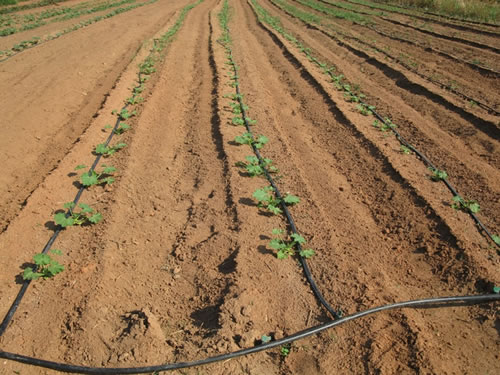
Figure 7. In-row drip irrigation preferentially waters the crop at this South Carolina farm. Photo credit: Mark Schonbeck, Virginia Association for Biological Farming.
For early plantings, start seedlings in individual pots or cells in a greenhouse, and transplant when they have about 2 true leaves. Plant in a high tunnel, or install row covers, low tunnels, or plastic mulch, a few days before planting to raise soil temperature. Anthony Flaccavento, organic vegetable grower in Abingdon, VA (Appalachian region) has found that 3-week old starts transplanted into plastic with in-row drip irrigation send out vines about 20 days after transplanting, and begin producing as soon as 45 days (pers. commun.).
Cultivation
Cucumber or winter squash grown without mulch should be kept clean cultivated for as long as practical to give the crop a 5–6 week head start on the weeds (Fig. 8). Cultivate shallowly when weeds are still small to avoid bringing up additional weed seeds or damaging crop roots. For optimum early season weed control, a tine weeder can be used for blind (full field) cultivation just before crop emergence, and again 5–7 days after emergence (Seaman, 2009).
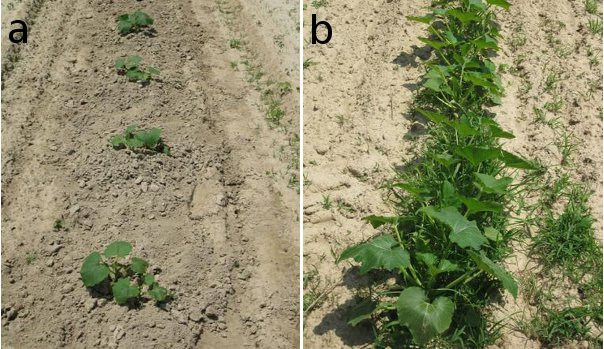
Figure 8. (a) Timely hoeing around young squash plants controls within-row weeds during the critical establishment period. (b) The critical time for within-row cultivation was missed. It will be very difficult to remove these weeds without disturbing the crop's shallow feeder roots. Photo credit: Mark Schonbeck, Virginia Association for Biological Farming.
Many growers manage weeds successfully in cucumber and squash by rototilling shallowly two or three times between crop rows, and hoeing around plants as needed, doing the last cultivation just before the vines begin to spread (Fig. 9). One effective cultivation system consists of sweeps or vegetable knives arranged to work on either side as the tractor straddles the crop row. The last cultivation can be done with the vegetable knives pointed toward the crop to reach under the leaves and work closer to the row (Seaman, 2009), but should be set to work shallowly enough not to damage crop roots.
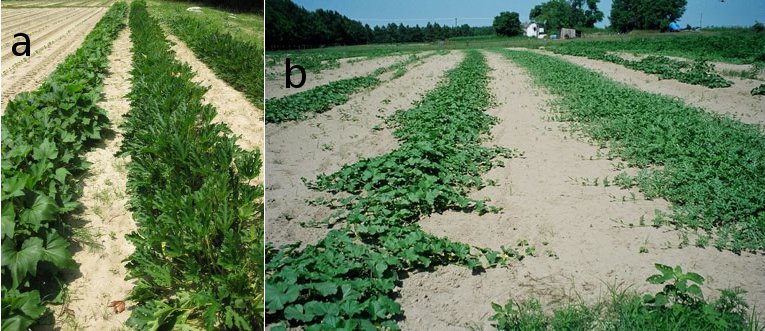
Figure 9. (a) Summer squash at beginning of harvest, and (b) cantaloupe and watermelon at vine spread, showing excellent weed control through timely cultivation. Photo credit: Mark Schonbeck, Virginia Association for Biological Farming.
Specialized cultivation tools that are effective for weeding around widely spaced plants such as squash include the Reigi weeder that is moved into and out of the crop row by an operator on a seat mounted behind the tractor; and a retractable blade cultivator developed by the farmer for high-residue minimum-till applications.
Once the crop is established, cultivators can be set to throw soil into the crop row to bury small weeds. One farmer in the Northeast has developed a filled furrow squash cultivation system, in which winter squash is transplanted into a furrow and hilled up during later cultivations, thereby burying within-row weeds while knocking out between-row weeds.
Mulching
Opaque synthetic mulches can suppress most within-row and near-row weeds; however, viny weeds like morningglories will grow toward and emerge through the planting holes. Nutsedges are known to puncture and emerge through plastic film, although canteloupe transplanted immediately after laying the plastic has been observed to spread and shade out yellow nutsedge quickly enough to give good control of the weed. Black plastic film mulch and landscape fabric warm the soil and promote rapid growth and early fruiting. White or reflective (aluminized) mulches are used to prevent excessive soil heating during hot summer weather, and to repel pests (Fig. 10). Landscape fabric can be reused for up to 10 seasons if it is taken up and stored out of the weather after harvest, a practice which can be economically feasible and effective on small scale farms (Hiu Newcomb, Potomac Vegetable Farms, Vienna, VA, pers. commun.)
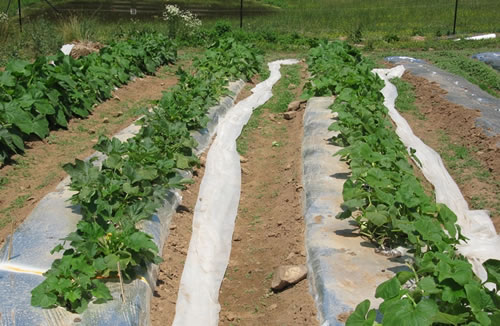
Figure 10. Squash grown in a light-reflective (aluminum coated), opaque, plastic film mulch, which blocks weed emergence, repels aphids and other pests, and prevents excessive soil heating during hot weather. Photo credit: Mark Schonbeck, Virginia Association for Biological Farming.
Weeds in alleys between plastic-mulched beds can be managed by cultivation, mowing, organic mulch, cover crops, or a combination of these methods. A mowed cover crop can provide season-long living mulch to keep alley weeds down (Fig. 11).
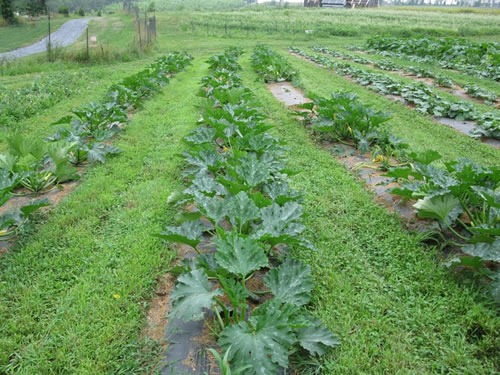
Figure 11. A living mulch of winter rye + white clover, maintained by mowing, eliminates the need for cultivation between plastic-mulched rows of summer squash at Red Wiggler Farm in Maryland. Photo credit: Mark Schonbeck, Virginia Association for Biological Farming.
Paper mulch has also been used successfully after last cultivation of alleys (Anthony Flaccavento, pers. commun.), and a combination of paper under an organic mulch can enhance suppression of aggressive weeds like common cocklebur and bermudagrass (Schonbeck, 1996).
Spreading an organic mulch like straw after the last cultivation can prolong weed suppression. Organic mulch should be applied when the soil has thoroughly warmed up, and when soil moisture is near optimum or drip irrigation has been installed. One caution: straw can become habitat for rodents that damage fruit (Seaman, 2009).
In fields with low to moderate weed populations comprised mainly of annual species, organic no-till management of a high biomass cover crop can give satisfactory weed control and high crop yields. A no-till planting aid designed for conservation tillage vegetable production systems has been used successfully for planting summer squash into rolled cover crops (Fig. 12). Because the cover crop mulch slows soil warming, this system is not recommended when earliness is desired; it works particularly well for winter squash and pumpkin.

Figure 12. Summer squash planted no-till into a mulch of rolled winter rye + hairy vetch in this field trial at Virginia Tech in Blacksburg, VA, gave high yields. Photo credit: Mark Schonbeck, Virginia Association for Biological Farming.
Preventing Weed Seed Set and Vegetative Reproduction
After the last cultivation, additional measures are needed to keep later-emerging weeds from setting seed or propagating vegetatively. For short-season crops, prompt tillage or mowing after the final harvest may be sufficient to curb weed propagation. If most of the weeds are annuals and simple perennials that reproduce by seed, mow close to the ground, and delay tillage a few weeks to give ground beetles and other weed seed predators a chance to consume any weed seeds that were formed. However, if nutsedges or other invasive perennials are present, till immediately after planting, wait until buried fragments begin to regenerate the weeds (shoots with 3–4 leaves), till again, and plant a fall cover crop.
It may pay to walk the fields before harvest, pulling or chopping out large weeds before they begin to set seed, especially in longer-season crops like winter squash. Hoe or cut invasive perennials at ground level to disrupt underground propagation.
Additional Weed Management Strategies
Dr. Ron Morse of the Virginia Tech Horticulture Department has had success with twin-row planting of large winter squash and pumpkin varieties. Two rows are planted 2–3 feet apart, with 9-foot wide alleys between successive pairs of rows. This promotes quick canopy closure in the narrow space in the twin row, allows cultivation or mowing for a longer period in the wide alleys, provides better weed control, and sometimes enhances yield.
Some farmers in the northeastern U.S. overseed red clover into winter squash or other cucurbits at the last cultivation, in part to manage late-season weeds. This hardy, shade-tolerant clover can establish under a dense canopy, and grows rapidly as soon as harvest, frost, or leaf senescence removes the canopy and lets light reach the ground. A good stand of clover may eliminate the need for post-harvest tillage for weed control, and enhances habitat for weed seed predators (Westerman et al., 2005). David Stern of Rose Valley Farm in Rose, NY has had good results with this strategy (Schonbeck, 2007), and clovers have been successfully overseeded into standing crops in late summer in the Appalachian region of Virginia as well.
References and Citations
- Adam, K. L. 2006. Squash bug and squash vine borer: Organic controls [Online]. ATTRA Publication IP298. National Sustainable Agriculture Information Service. Available at: https://attra.ncat.org/attra-pub/summaries/summary.php?pub=138 (verified 18 July, 2011).
- Berry, A. D., W. M. Stall, B. Rathinasabapathi, G. E. MacDonald, and R. Charudattan. 2006. Smooth pigweed (Amaranthus hybridus L.) and livid amaranth (Amaranthus lividus) interference with cucumber (Cucumis sativus). Weed Technology 20: 227–231. (Available online at: http://www.wssajournals.org/doi/abs/10.1614/WT-04-239R.1) (verified 18 July, 2011).
- Connolly, B. 2005. Saving cucurbit seed. The Natural Farmer 2(65): 13–15. Available online at http://www.nofa.org/tnf/pdfs/Summer2005.pdf (verified 18 July, 2011).
- Friesen, G. H. 1978. Weed interference in pickling cucumbers (Cucumis sativus). Weed Science 26: 626–628. (Available online at: http://www.jstor.org/stable/4042942) (verified 11 Aug 2011).
- Johnson, W. C., and B. G. Mullinix. 2008. Cultural control of yellow nutsedge (Cyperus esculentus) in transplanted cantaloupe (Cucumis melo) by varying application timing and type of thin-film mulches. Crop Protection Journal 27: 735-739. (Available online at: http://dx.doi.org/10.1016/j.cropro.2007.10.008) (verified 11 Aug 2011).
- Maynard, D. N., and G. J. Hochmuth. 1997. Knott's handbook for vegetable growers, 4th ed. John Wiley and Sons, New York.
- Noble, D. 2009. Working toward better cucurbits: Weed management strategies for the coming season [Online]. Available at: http://www.growingmagazine.com/fruits/working-toward-better-cucurbits/ (verified 18 July, 2011.)
- Peet, M. 1996. Sustainable practices for vegetable production in the South. Focus Publishing, R. Pullins Company, Newburyport, MA.
- Schonbeck, M. W. 1996. Mulching with paper. The Natural Farmer 2: 22–23.
- Schonbeck, M. 2007. Beating the weeds with low-cost cover crops, intercropping and steel. The Virginia Biological Farmer 30: 7–8.
- Seaman, A. (ed.) 2009. 2009 production guide for organic cucumbers and squash. NYS IPM Publication No. 135. Cornell University and the New York State IPM Program. (Available online at: http://www.nysipm.cornell.edu/organic_guide/cucurbit.pdf) (verified 18 July, 2011).
- Stall, W. M. 2009. Weed control in cucurbit crops (muskmelon, cucumber, squash, and watermelon) [Online]. Available at http://edis.ifas.ufl.edu/wg029 (verified 18 July, 2011).
- University of California at Davis. 2008. Cucurbits: Integrated weed management [Online]. Available at: http://www.ipm.ucdavis.edu/PMG/r116700111.html (verified 18 July, 2011).
- Webster, T. M. 2002. Weed survey – Southern states. Vegetable, fruit and nut crops subsection. Proceedings of the Southern Weed Science Society 55: 237–258.
- Webster, T. M. 2006. Weed survey – Southern states. Vegetable, fruit and nut crops subsection. Proceedings of the Southern Weed Science Society 59: 260–277.
- Westerman, P. L., M. Liebman, F. D. Menalled, A. H. Heggenstaller, R. G. Hartzler, and P. M. Dixon. 2005. Are many little hammers effective? Velvetleaf (Abutilon theophrasti) population dynamics in two- and four-year crop rotation systems. Weed Science 53: 382–392. (Available online at: http://www.wssajournals.org/doi/abs/10.1614/WS-04-130R) (verified 18 July, 2011).



